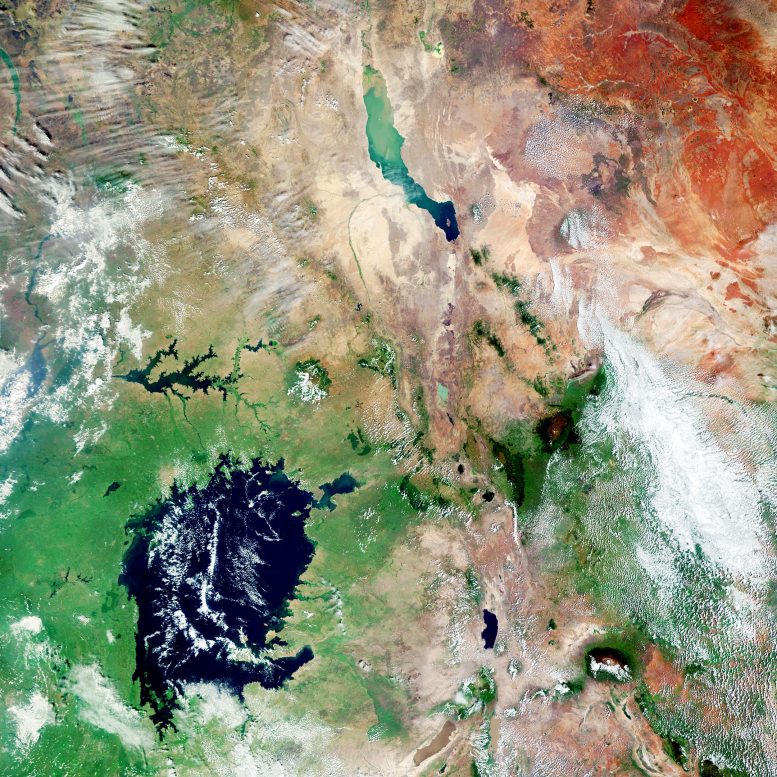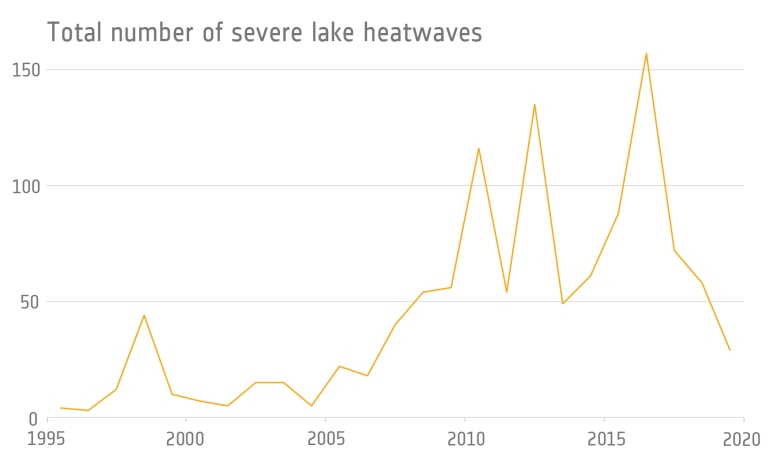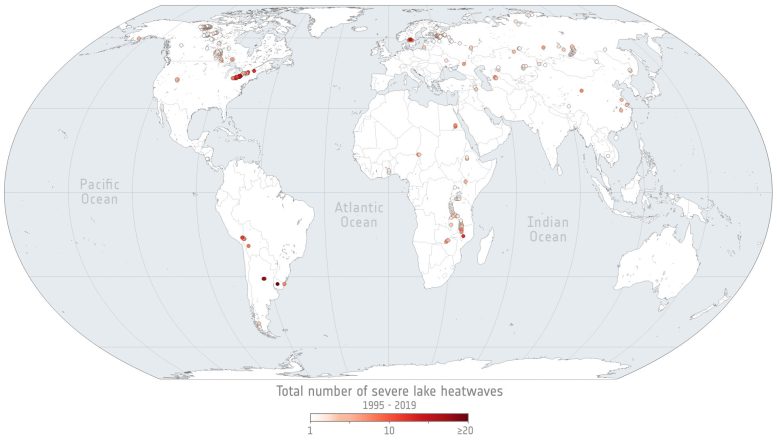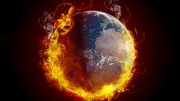
Lake Victoria and Lake Turkana are featured in this image captured by the Copernicus Sentinel-3 mission. These two large African lakes were included in a new study published in the AGU journal Geophysical Research Letters. According to the study’s main findings, lakes at lower latitudes such as these are anticipated to experience the greatest increase in severe lake heatwaves. Credit: Contains modified Copernicus Sentinel (2021), processed by ESA, CC BY-SA 3.0 IGO
According to a new study, the world’s largest lakes are being hit by severe heatwaves six times as frequently as they were around two decades ago. Using data from ESA’s Climate Change Initiative, the study states that severe lake heatwaves are twice as likely to occur on average, compared to a pre-industrial climate.
Published on February 24, 2022, in the AGU journal Geophysical Research Letters, the study is one of the first to quantify how anthropogenic climate change has influenced lake heatwaves – offering a new perspective on just one of the ways lakes are responding to the warming climate.
The researchers found that severe and extreme heatwaves may be three times more likely at 1.5°C (2.7°F) of global warming, which is the goal set under the Paris Agreement. Under a 3°C (5.4°F) global warming scenario, the most extreme warming scenario, heatwaves could be up to 25 times more likely by the end of the century.
The researchers also found that the anthropogenic contribution was also higher in tropical lakes, mirroring other studies that have found lower-latitude regions bear the brunt of climate change impacts.
Iestyn Woolway, lead author of the study and former research fellow at ESA’s Climate Office, commented, “What really stood out was the magnitude of human contribution: Most of the severe lake heatwaves we looked at had a significant anthropogenic imprint. And looking at how these heatwaves will change in the future, the magnitude of change we expect to see in the coming decades was quite striking.”
The new study uses lake surface temperature data from ESA’s Climate Change Initiative Lake project which includes data collected by the European Remote Sensing satellite (ERS-2) and Envisat.
From 1000 lakes selected around the world, the team carefully picked out visible lakes that were large enough to sample temperatures from multiple points. This left 78 large lakes worldwide, including Lake Baikal, Lake Victoria and Lake Erie, with enough data from 1995 to 2019 for them to analyze.

The total number of severe lake heatwaves detected from 1995 to 2019. Credit: ESA (Data: Woolway et al., 2022)
The researchers paired the historical data with climate models from the Intersectoral Impact Model Intercomparison Project to estimate how much human climate change has contributed to the lake heatwaves, and to predict how frequently they will occur over the next century.
Woolway concluded: “The only way to deal with this is to reduce global warming. If temperatures continue to increase, lake heatwaves will get progressively worse.”
Clement Albergel, Climate Applications Scientist at ESA, commented, “Satellite observations allow for a regional to global assessment of lake responses to a changing environment and the impacts of human-kind. The long-term and consistent records developed by ESA’s Climate Initiative provide the empirical record to support climate science and inform effective climate action to address and build resilience to the negative consequences of change.”
Reference: “Severe Lake Heatwaves Attributable to Human-Induced Global Warming” by R. Iestyn Woolway, Clément Albergel, Thomas L. Frölicher and Marjorie Perroud, 24 February 2022, Geophysical Research Letters.
DOI: 10.1029/2021GL097031










“What really stood out was the magnitude of human contribution: Most of the severe lake heatwaves we looked at had a significant anthropogenic imprint.”
Just what is this “significant anthropogenic imprint?” It is easy to make unsupported claims. I’d like to see a definition and evidence for the claim. Actually, their abstract says unequivocally, “However, unlike their atmospheric counterparts, it is currently unknown to what extent lake heatwaves are altered by human-induced climate change.” They appear to contradict themselves.
“The researchers found that severe and extreme heatwaves MAY be three times more likely at 1.5°C of global warming, …”
That MAY be true for the world. However, there is no evidence that heatwaves are becoming more frequent or severe in the US, as I have demonstrated:
https://wattsupwiththat.com/2019/09/06/the-gestalt-of-heat-waves/
Their assertions and conclusions depend entirely on computer models of unknown reliability and applicability to their study.